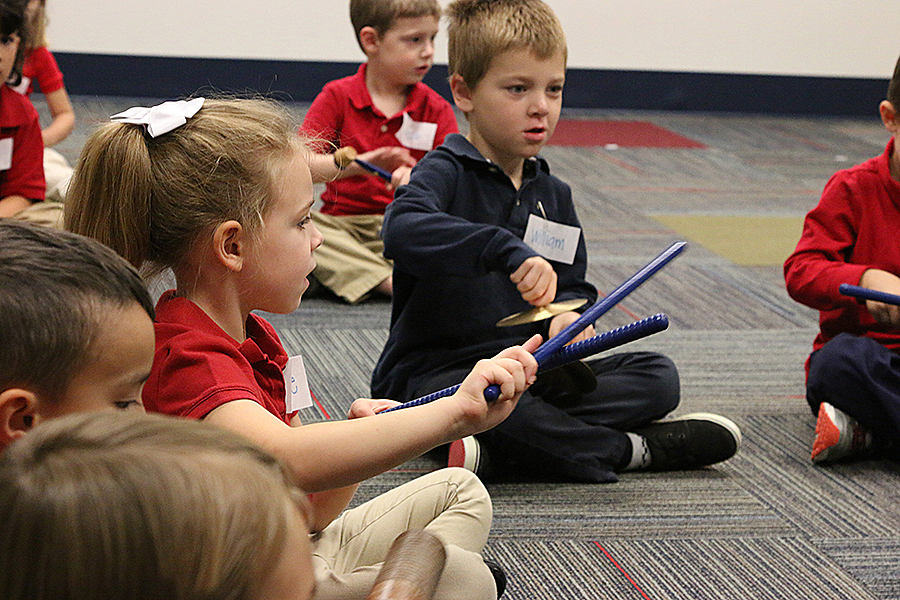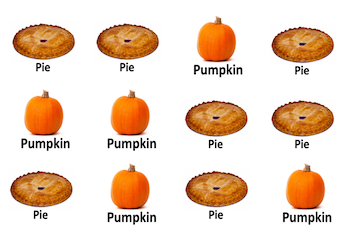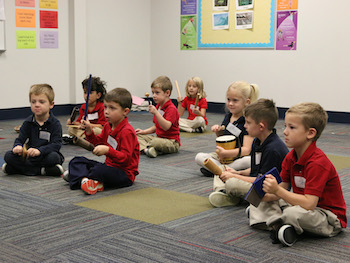SUBJECTS
GRADE
Show Results
Pie Rhythms

Lesson Summary
- Play rhythms in a steady beat using body percussion or non-pitched percussion instruments.
- Create, say, and play rhythms using word syllabication.
Lesson Plan and Procedure
Lesson Key Facts
- Grade(s): K, 1, 2
- Subject(s): English Language Arts, Music
- Duration of lesson: 15 minutes
- Author(s): Jennifer Purdy
The Thanksgiving season is an ideal time to use this lesson. Pie can be referenced and explored as a tradition of many people. After the initial lesson, repeat activities or add variations during subsequent 15-minute lessons. This lesson could be done with any words that students can decode and read. This activity could be repeated at various times throughout the year to help reinforce the concepts of decoding and syllabication. For example, use hat and mitten as a winter activity.
Show students the card that reads pie. Invite the students to repeat the word over and over to a steady beat. Do the same for the card that says pumpkin. Help students discover the word pie is one syllable or sound in one beat. The word pumpkin is two syllables or sounds in one beat.
 Have a student arrange the pie and pumpkin cards in four rows of four cards. Invite the students to say the words in sequence, one word per beat.
Have a student arrange the pie and pumpkin cards in four rows of four cards. Invite the students to say the words in sequence, one word per beat.
Teacher: Let’s read the words in your sequence together in a steady beat. (For example: “pie, pie, pumpkin, pie.”)
Help students to use non-pitched instruments such as rhythm sticks, drums, or body percussion—such as clapping, patting, or stomping—to play the rhythm of the words as they say them. Each card represents one beat. The rhythm is the combination of one or two sounds / syllables per beat / card.
Teacher: This time we're going to think the words in our minds as we play the rhythm of the words.
Have students take turns arranging the cards, creating and playing new patterns. Maintain a steady tempo that is slow enough to ensure they can follow. Practice and repeat any difficult sections. Determine and instruct students beforehand whether they will say the words as they play or play only.
Activity Variations
 Assign a different non-pitched percussion instrument to each picture. Students play only on their assigned picture.
Assign a different non-pitched percussion instrument to each picture. Students play only on their assigned picture.- Vary the dynamics and tempo.
- Invite students to play their 16-beat sequence to an accompaniment such as “Alabama Gal,” "Chumbara," or "Weevily Wheat." These songs come from the Utah State Board of Education Songbook, available for teachers to use. There are additional songs for all grade levels free for classroom use.
- Consider alternating 16 counts of playing the steady beat with playing the 16-count pie sequence.
Learning Objectives
- Differentiate beat and rhythm.
- Conceptualize, generate, and organize artistic ideas.
- Play rhythms based on words and pictures (iconic notation).
- Decode words.
- Read with accuracy and fluency.
- Apply syllabication of words.
Utah State Board of Education Standards
This lesson can be used to meet standards in many grades and subject areas. We will highlight one grade’s standards to give an example of application.
Grade 1 Music
Strand: CREATE (1.M.CR): Students will conceptualize, generate, and organize artistic ideas and work. They will complete and refine musical works.
Standard 1.M.CR.3: Organize personal musical ideas using iconic notation or recordings.
Standard 1.M.P.2: Explore the effects of various timbres, dynamic levels, and tempos using voice, movement, and simple instruments.
Standard 1.M.P.3:
Perform beat versus rhythm.
Respond with body percussion, voice, or simple instruments to visual representation of rhythm patterns.
Standard 1.M.CO.1: Describe how music relates to personal experience, use life experience and additional content knowledge to inspire and respond to music, and deepen understanding of another content area through music.
Grade 1 English Language Arts
Standard 1.R.2: Demonstrate mastery of age-appropriate phonological awareness skills.
Standard 1.R.4: Read grade-level text* with accuracy and fluency to support comprehension. (RL & RI)
Equipment and Materials Needed
- A set of prepared picture cards
- Music track options:
- Non-pitched percussion instruments (optional)
Additional Resources
- Utah State Board of Education Elementary Songbook (https://emedia.uen.org/curated-collections/739?batch_start=40&_=1725644821185)
Image References
Image 1: James Huston.
Image 2: Jennifer Purdy.
Image 3: James Huston.

www.education.byu.edu/arts/lessons
 Download
Download